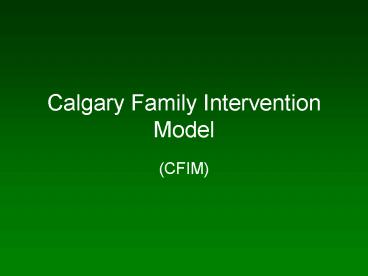Calgary Family Intervention Model - PowerPoint PPT Presentation
1 / 22
Title:
Calgary Family Intervention Model
Description:
A change in one domain will have an impact on another domain ... family called re: their son's impending admission to ICU following head injury ... – PowerPoint PPT presentation
Number of Views:5136
Avg rating:3.0/5.0
Title: Calgary Family Intervention Model
1
Calgary Family Intervention Model
- (CFIM)
2
Purpose
- To promote, improve, and/or sustain effective
family functioning in three domains - Affective
- Behavioral
- Cognitive
3
- A change in one domain will have an impact on
another domain - The most profound and sustaining change will be
that which occurs in the familys beliefs
(cognition).
4
Indications for Family Intervention
- Illness of one family member causing detrimental
effect on another - Behavior of family member contributes to problems
of another - One family members improved situation results in
symptoms on another - Development of emotional, behavioral, or physical
problem within the context of an already existing
illness
5
- 5. Illness newly diagnosed.
- 6. Marked deterioration of a family members
condition. - 7. Chronically ill family member moves home
- 8. Individual or family milestone missed or
delayed - 9. Chronically ill family member dies.
6
Contraindications
- All family members decline pursuing help as a
family - Family desires assistance, but from another
professional.
7
Types of Interventions
- A myriad of interventions nurses can choose from
to promote or facilitate change in a family
system - Interventions must be tailored to fit each family
and the chosen domain of functioning
8
Interventions Should Be
- Related to the issue or problem
- Derived from a hypothesis
- Match the familys style of relating
- Linked to the familys strength
- Consistent with the familys ethnicity/religious
beliefs - Consider whether they will be useful or effective
rather than "right
9
Interventive Questions
- Intended to actively effect change in any or all
three domains - Circular questions not just assessment questions
they are family interventions as well
10
Circular Questions
- Reveal understanding explanations of problems
- Seek out differences between people, events,
ideas or beliefs - Provide new information to the family about
itself - Intended to facilitate behavioral change
11
Examples of Circular Questions
- Who in your family is managing the situation
best? - What is most helpful to your mother in relieving
her anxiety?
12
Types of Circular Question
- Difference explores differences between people,
between relationships and times. - Hypothetical useful to help family consider
alternate actions or meanings - Behavioral Effect explore connections between
the effect of one persons behavior on another - Triadic a questions addressed to a third person
about the relationships between two other people
13
Difference Questions
- Explores differences between people,
relationships, time, ideas and beliefs
14
Sample Difference Questions
- CognitiveWhat information would be most helpful
to you in order to manage your sons diabetes? - Affective
- Who is most worried about the heredity
aspects of diabetes? - Behavioral
- Who is the best person in getting your son to
take his insulin?
15
Sample Hypothetical or Future Oriented Questions
- Cognitive
- What do you think will happen when you take
your wife home? - Affective
- If your wifes illness doesnt improve, who
will be most affected? - Behavioral
- If your wife isnt able to come home, what do
you think your children will do?
16
Sample Behavioral Effect Questions
- Cognitive
- How do you make sense of your daughters
illness? - Affective
- How do you feel when your daughter cries
after her injections - Behavioral
- What do you do when your husband tells you
that hes afraid to visit your daughter?
17
Sample Triadic Questions
- Cognitive
- If your brother were not dealing drugs, what
would your mother think about his going out with
his friends? - Affective
- How does your mother feel when your father
goes out to the bar with his friends? - Behavioral
- If your mother were willing to consider
solutions to her drinking problem what would she
say to your father?
18
Other Interventions
- Cognitive Domain
- Offering information or opinions
- Reframing
19
Other Interventions
- Affective Domain
- Validating or normalizing emotional responses
- Drawing forth family supports
- Commendations
20
Other Interventions
- Behavioral Domain
- Encouraging family members as caregivers
- Encouraging respite
21
Case Study 1
- Jackson family called re their sons impending
admission to ICU following head injury
unconsciousness from skiing accident - Wayne, age 26 years, slid 900 meters down
mountain - Family lived about 9 hours drive away from this
hospital
22
Case Study 1
- During the long drive to hospital, Waynes
71-year-old father developed urinary retention - Family stopped at a small hospital along the way
and an indwelling catheter was inserted - Family arrived at 3 AM, saw Wayne briefly and
went to find a hotel - Father required prostate surgery while Wayne in
hospital

